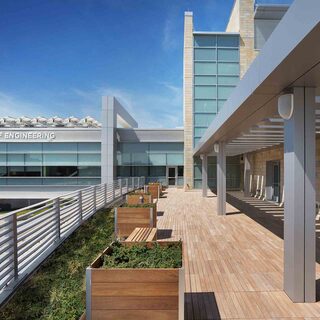Tradeline's industry reports are a must-read resource for those involved in facilities planning and management. Reports include management case studies, current and in-depth project profiles, and editorials on the latest facilities management issues.
Latest Reports
Jacobs School of Medicine and Biomedical Sciences
The new Jacobs School of Medicine and Biomedical Sciences at the University at Buffalo returns UB’s medical school to downtown Buffalo and allows it to increase enrollment by 25 percent, with the goal of pursuing breakthroughs in biomedical research and transforming healthcare in Western New York. Three research floors are sandwiched between the classroom and lecture hall areas on the lower floors—which include a transit hub on the ground floor—and the more specialized teaching spaces on the upper stories. Deliberately positioned as a gateway to the medical campus, two L-shaped structures are linked by a six-story, light-filled atrium featuring multiple collaboration areas.
Connecting Engineering with Business at the University of Alaska Fairbanks
The new engineering building at the University of Alaska Fairbanks (UAF) not only relieves overcrowding at the College of Engineering and Mines, it also cultivates interdisciplinary research and entrepreneurship, with open, flexible labs; the incorporation of computer science; and a direct link to the School of Management. These features combine to create an environment where students learn hands on how to solve problems and speed their ideas to market, in a facility made transparent with extensive glazing, both inside and out.
Biomedical Sciences Partnership Building (BSPB)
The 10-story University of Arizona Biomedical Sciences Partnership Building (BSPB), the tallest addition to the 28-acre Phoenix Biomedical Campus, allows academic research scientists to collaborate with local healthcare providers and private companies to find new medical cures and treatments. BSPB is organized to encourage collegiality, collaboration, and customization. The building was programmed and planned before the occupants were selected, so the floor plates were organized in a general framework of labs, support spaces, and offices. The adaptable plan and utility distribution backbone was designed to easily modify to suit different types and scales of interdisciplinary research on the same floor, including computational, instrumentational, and cellular and molecular research. A multi-purpose translational core facility opens to the main lobby and is available to outside clinical and industry research partners.
Novartis' Activity-Based Work Environments Have Broad Appeal
The Novartis headquarters in Sydney, Australia, demonstrates how to create a multi-tenant space where employees at all levels can choose their work setting depending on their activities, as long as there is abundant space for collaboration and informal interaction across all sectors. To create appeal for Novartis employees and attract new tenants, the redesigned floor plan offers several options for activity-based workspace, and has multi-purpose furnishings, demountable walls for offices and meetings rooms, and cast-in-place conduits for data and power in the slab with floor boxes.
Engineering Hall
Envisioned to create a new engineering complex with existing Rowan Hall, the new Engineering Hall is home to teaching and research laboratories for biomedical, civil and environmental, and electrical and computer engineering. The building includes laboratory support spaces, shops, classrooms, faculty offices, collaboration spaces, group study rooms, and student commons. The two facilities are connected by a bridge crossing a campus roadway.





